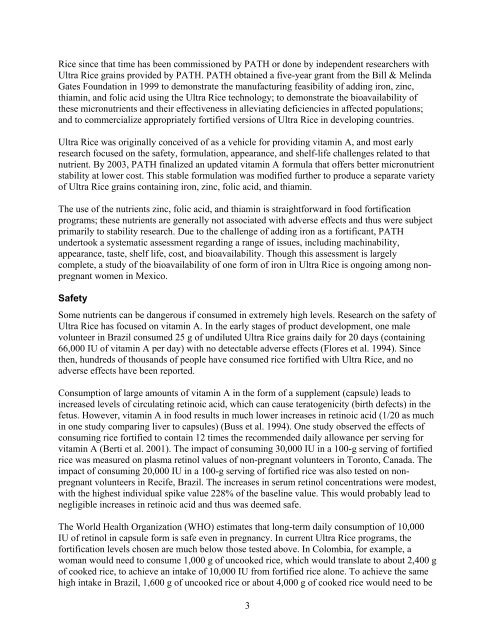The Research Behind the Ultra Rice® Technology - Path
The Research Behind the Ultra Rice® Technology - Path
The Research Behind the Ultra Rice® Technology - Path
Create successful ePaper yourself
Turn your PDF publications into a flip-book with our unique Google optimized e-Paper software.
Rice since that time has been commissioned by PATH or done by independent researchers with<br />
<strong>Ultra</strong> Rice grains provided by PATH. PATH obtained a five-year grant from <strong>the</strong> Bill & Melinda<br />
Gates Foundation in 1999 to demonstrate <strong>the</strong> manufacturing feasibility of adding iron, zinc,<br />
thiamin, and folic acid using <strong>the</strong> <strong>Ultra</strong> Rice technology; to demonstrate <strong>the</strong> bioavailability of<br />
<strong>the</strong>se micronutrients and <strong>the</strong>ir effectiveness in alleviating deficiencies in affected populations;<br />
and to commercialize appropriately fortified versions of <strong>Ultra</strong> Rice in developing countries.<br />
<strong>Ultra</strong> Rice was originally conceived of as a vehicle for providing vitamin A, and most early<br />
research focused on <strong>the</strong> safety, formulation, appearance, and shelf-life challenges related to that<br />
nutrient. By 2003, PATH finalized an updated vitamin A formula that offers better micronutrient<br />
stability at lower cost. This stable formulation was modified fur<strong>the</strong>r to produce a separate variety<br />
of <strong>Ultra</strong> Rice grains containing iron, zinc, folic acid, and thiamin.<br />
<strong>The</strong> use of <strong>the</strong> nutrients zinc, folic acid, and thiamin is straightforward in food fortification<br />
programs; <strong>the</strong>se nutrients are generally not associated with adverse effects and thus were subject<br />
primarily to stability research. Due to <strong>the</strong> challenge of adding iron as a fortificant, PATH<br />
undertook a systematic assessment regarding a range of issues, including machinability,<br />
appearance, taste, shelf life, cost, and bioavailability. Though this assessment is largely<br />
complete, a study of <strong>the</strong> bioavailability of one form of iron in <strong>Ultra</strong> Rice is ongoing among nonpregnant<br />
women in Mexico.<br />
Safety<br />
Some nutrients can be dangerous if consumed in extremely high levels. <strong>Research</strong> on <strong>the</strong> safety of<br />
<strong>Ultra</strong> Rice has focused on vitamin A. In <strong>the</strong> early stages of product development, one male<br />
volunteer in Brazil consumed 25 g of undiluted <strong>Ultra</strong> Rice grains daily for 20 days (containing<br />
66,000 IU of vitamin A per day) with no detectable adverse effects (Flores et al. 1994). Since<br />
<strong>the</strong>n, hundreds of thousands of people have consumed rice fortified with <strong>Ultra</strong> Rice, and no<br />
adverse effects have been reported.<br />
Consumption of large amounts of vitamin A in <strong>the</strong> form of a supplement (capsule) leads to<br />
increased levels of circulating retinoic acid, which can cause teratogenicity (birth defects) in <strong>the</strong><br />
fetus. However, vitamin A in food results in much lower increases in retinoic acid (1/20 as much<br />
in one study comparing liver to capsules) (Buss et al. 1994). One study observed <strong>the</strong> effects of<br />
consuming rice fortified to contain 12 times <strong>the</strong> recommended daily allowance per serving for<br />
vitamin A (Berti et al. 2001). <strong>The</strong> impact of consuming 30,000 IU in a 100-g serving of fortified<br />
rice was measured on plasma retinol values of non-pregnant volunteers in Toronto, Canada. <strong>The</strong><br />
impact of consuming 20,000 IU in a 100-g serving of fortified rice was also tested on nonpregnant<br />
volunteers in Recife, Brazil. <strong>The</strong> increases in serum retinol concentrations were modest,<br />
with <strong>the</strong> highest individual spike value 228% of <strong>the</strong> baseline value. This would probably lead to<br />
negligible increases in retinoic acid and thus was deemed safe.<br />
<strong>The</strong> World Health Organization (WHO) estimates that long-term daily consumption of 10,000<br />
IU of retinol in capsule form is safe even in pregnancy. In current <strong>Ultra</strong> Rice programs, <strong>the</strong><br />
fortification levels chosen are much below those tested above. In Colombia, for example, a<br />
woman would need to consume 1,000 g of uncooked rice, which would translate to about 2,400 g<br />
of cooked rice, to achieve an intake of 10,000 IU from fortified rice alone. To achieve <strong>the</strong> same<br />
high intake in Brazil, 1,600 g of uncooked rice or about 4,000 g of cooked rice would need to be<br />
3
















